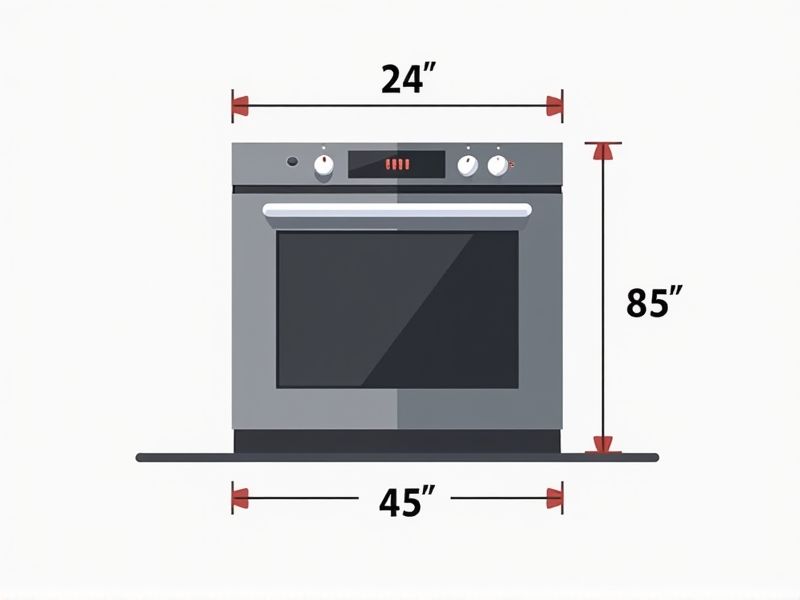
When shopping for an oven, knowing the standard dimensions can help you choose a model that fits seamlessly into your kitchen space. Most standard ovens are about 30 inches wide, 27 to 29 inches high, and 23 to 25 inches deep, though wall ovens and ranges may have slight variations. Before making a purchase, measure your available space carefully and compare it to the product's specifications. This ensures proper installation and prevents any frustrating surprises during delivery or setup.
Exterior Width
The standard exterior width of a conventional oven typically measures between 30 to 36 inches, making it a suitable choice for most kitchen spaces. This width allows for a variety of cooking functionalities, accommodating multiple racks and larger cooking vessels. When selecting an oven, consider that models with a 30-inch width are common in residential kitchens, while professional-grade options often extend to 36 inches for increased capacity. Ensuring your kitchen layout can support this width is crucial for an efficient cooking experience.
Interior Capacity
Standard ovens typically offer an interior capacity ranging from 4.0 to 6.0 cubic feet, accommodating a variety of cooking needs. This space is suitable for baking multiple dishes simultaneously, such as a large turkey or multiple trays of cookies. The design often includes adjustable racks, allowing you to optimize the use of vertical space within the oven. When selecting a standard oven, consider how the interior capacity aligns with your cooking habits and the size of your household.
Depth With Handle
A standard oven typically measures 24 to 30 inches in depth, not including the handle, which can add an extra 2 to 4 inches. The handle design is usually ergonomically crafted for comfortable gripping while maintaining a sleek aesthetic. Standard ovens also feature a depth that allows for appropriate air circulation, ensuring even heating across cooking surfaces. Be mindful of the overall dimension to guarantee a seamless fit within your kitchen cabinetry.
Height
The standard height for residential ovens typically ranges from 27 to 30 inches, allowing for ergonomic accessibility in kitchens. Many manufacturers design ovens at 28 inches high, which aligns with most counter heights for seamless integration and convenience. If you're considering installation, ensure that your cabinetry complements this height for a cohesive look. You might also find varying heights in professional-grade ovens, which can extend up to 36 inches, catering to chefs who prefer a more elevated cooking experience.
Cooktop Surface Height
The standard cooktop surface height for ovens typically ranges between 28 to 36 inches from the floor, ensuring ergonomic access for most users. This height accommodates various cooking techniques while providing a comfortable standing position to reduce strain. For individuals, particularly those 5'2" to 6'0" tall, this range enables enhanced visibility and maneuverability while handling pots and pans. When choosing a standard oven, consider your kitchen layout and how the cooktop height complements your overall cooking experience.
Oven Rack Positions
Standard ovens typically feature multiple rack positions, generally ranging from three to five levels, allowing for optimal cooking flexibility. Utilizing the top rack position is ideal for broiling, while the bottom is best for baking larger dishes that require more even heating. When using your oven for multiple items, placing them on separate racks can enhance air circulation and ensure more even cooking. It's essential to adjust rack positions based on the size and type of food being prepared to achieve the best results.
Door Swing Clearance
Standard ovens typically require a door swing clearance of at least 30 inches to ensure safe and easy access. This clearance allows for unobstructed movement, facilitating both loading and unloading of dishes. Considering that many standard ovens have a depth of around 24 to 30 inches, it's essential to plan your kitchen layout accordingly. Ensuring adequate door swing clearance can enhance your cooking experience, preventing accidental bumps or spills during meal preparation.
Control Panel Width
The standard control panel width of an oven typically ranges from 24 to 30 inches, accommodating various kitchen designs and functionalities. This measurement not only affects the aesthetics of your cooking space but also enhances user accessibility to settings and features. A wider control panel may include additional controls like touchscreens or extra dials, which facilitate more precise cooking adjustments. When selecting an oven, consider the control panel width to ensure it fits your cooking habits and kitchen layout effectively.
Feet Level Adjustment
The standard oven features feet level adjustment capabilities, allowing precise positioning for optimal cooking performance. This adjustment range typically offers a height variation of 1 to 2 inches, accommodating various flooring types and ensuring stability. Maintaining a level oven not only enhances efficiency but also improves safety by preventing tipping or uneven cooking. For best results, regularly check and adjust the feet to suit your kitchen layout and your specific cooking needs.
Wall Clearance Requirements
Standard ovens typically require a wall clearance of at least 2 inches on either side to ensure proper ventilation and safety. This spacing is vital to prevent overheating, which can lead to malfunction. For optimal performance, a minimum rear clearance of 2 to 4 inches is recommended. You should also check your manufacturer's specifications, as some models may have specific clearance requirements that vary from the standard guidelines.
